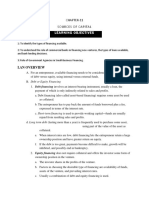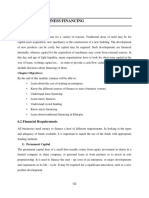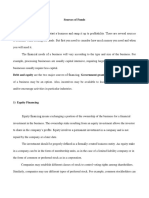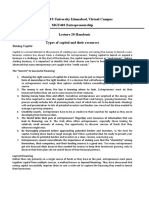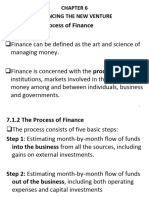Financing the business
Reference
• Ch 11, pg313pdf, Entrepreneurship, Robert D. Harish, Michel P. Peter
and Dean A. Shepherd, 10th edition / latest edition, McGraw-Hill
Education
�Introduction
• One of the most difficult problems in the new venture creation
process is obtaining financing. For the entrepreneur, financing for the
private firm should be considered from the perspective of debt versus
equity and using internal versus external funds
�Types of financing
• There are two general types of financing available: debt financing and
equity financing.
�Debt Financing
• Debt financing is a financing method involving an interest-bearing
instrument, usually a loan, the payment of which is only indirectly
related to the sales and profits of the venture. Typically, debt
financing (also called asset-based financing) requires that some asset
(such as a car, house, inventory, plant, machine, or land) be used as
collateral.
• Debt financing requires the entrepreneur to pay back the amount of
funds borrowed as well as a fee usually expressed in terms of the
interest rate. There can also be an additional fee, sometimes referred
to as points, for using or being able to borrow the money.
�• If the financing is short term (less than one year), the money is usually used to provide
working capital to finance inventory, accounts receivable, or the operation of the business.
The funds are typically repaid from the resulting sales and profits of the business during
the year.
• Long-term debt (lasting more than one year) is frequently used to purchase some asset
such as a piece of machinery, land, or a building, with part of the value of the asset
(usually from 50 to 80 percent of the total value) being used as collateral for the long-term
loan.
• Particularly when interest rates are low, debt (as opposed to equity) financing allows the
entrepreneur to retain a larger ownership portion in the venture and have a greater return
on the equity. The entrepreneur needs to be careful that the debt not be so large that
regular interest payments become difficult if not impossible to make, a situation that will
inhibit growth and development and possibly end in bankruptcy. Using debt as the
financing instrument is called leveraging the firm. The higher the amount of leverage
(debt/total assets), the greater the risk in the venture.
�Equity financing
• Obtaining funds for the company in exchange for ownership
• Equity financing does not require collateral and offers the investor
some form of ownership position in the venture. The investor shares
in the profits of the venture, as well as any disposition [selling] of its
assets on a pro rata basis based on the percentage of the business
owned.
• Key factors favoring the use of one type of financing over another are
the availability of funds, the assets of the venture, and the prevailing
interest rates.
• Frequently, an entrepreneur meets financial needs by employing a
combination of debt and equity financing.
�• All ventures will have some equity, as all ventures are owned by some
person or institution.
• Although the owner may sometimes not be directly involved in the
day-to-day management of the venture, there is always equity funding
involved that is provided by the owner.
• The amount of equity involved will of course vary by the nature and size of
the venture. In some cases, the equity may be entirely provided by the
owner, such as in a small ice cream stand or pushcart in the mall or at a
sporting event.
• Larger ventures may require multiple owners, including private investors
and venture capitalists. This equity funding can provide the basis for debt
funding, which together make up the capital structure of the venture.
�Internal fund
• The funds most frequently employed are internally generated funds.
• Internally generated funds can come from several sources within the
company: profits, sale of assets, reduction in working capital, extended
payment terms, and accounts receivable.
• In every new venture, the start-up years usually involve putting all, or at
least most of the profits back into the venture; even outside equity
investors do not expect any payback in these early years.
• Assets, whenever possible, should be on a rental basis (preferably on a
lease with an option to buy), not an ownership basis, particularly when
there is not a high level of inflation and the rental terms are favorable. Also,
activities should be outsourced whenever possible. This helps the
entrepreneur conserve cash, a practice that is particularly critical during the
start-up phase of the company’s operation when cash is scarce.
�• Short-term, internal funds can also be reducing short-term assets: inventory, cash,
and other working-capital items. Sometimes an entrepreneur can generate the
needed cash for a period of 30 to 60 days through extended payment terms from
suppliers.
• Although care must be taken to ensure good supplier relations and continuous
sources of supply, taking a few extra days to pay can generate needed short-term
funds.
• A final method of internally generating funds is collecting bills (accounts
receivable) more quickly. Key account holders should not be irritated by
implementation of this practice, as certain customers have established payment
practices. Mass merchandisers, for example, pay supplying companies in 60 to 90
days, regardless of a supplying company’s accounts receivable policy, the size of
the company, or the discount offered for prompt payment. If a company wants
this mass merchandiser to carry its product, it will have to live with this payment
schedule.
�External funds
• The other general source of funds is external to the venture.
Alternative sources of external financing need to be evaluated on
three bases: the length of time the funds are available, the costs
involved, and the amount of company control lost.
• In selecting the best source of funds, each of the sources indicated in
Table next slide need to be evaluated along these three dimensions.
• The more frequently used sources of funds (self, family and friends,
commercial banks, private investors (angels), R&D limited
partnerships, government loan programs and grants, venture capital,
and private placement)
��Personal fund
• Entrepreneurs own fund.
• It is a must, otherwise bank, investors will not get trust.
• Often referred to as blood equity, the typical sources of personal
funds include savings, life insurance, or mortgage on a house or car.
These outside providers of capital feel that the entrepreneur may not
be sufficiently committed to the venture if he or she does not have
money invested.
• Entrepreneurs should always remember that it is not the amount of
the capital but rather the fact that all monies available are committed
that makes outside investors feel comfortable with their commitment
level and therefore more willing to invest, in most count
�Family and friends
• After the entrepreneur, family and friends are the usual source of capital
for a new venture. They are most likely to invest due to their relationship
with the entrepreneur.
• This helps overcome one portion of uncertainty felt by impersonal
investors—they have knowledge of the entrepreneur. Family and friends
usually provide a small amount of equity funding for new ventures,
reflecting in part the small amount of capital needed for most new ventures
at this time.
• Although it is relatively easy to obtain money from family and friends, like
all sources of capital, there are positive and negative aspects of obtaining
and using these funds. Although the amount of money provided may be
small, if it is in the form of equity financing, the family members or friends
then have an ownership position in the venture and all rights and privileges
of that position. Relationship may get bitter in tough times.
�Bank loans by commercial banks
• Commercial banks are by far the source of short-term funds most
frequently used by the entrepreneur when collateral is available.
• The funds provided are in the form of debt financing and, as such, require
some tangible guaranty or collateral—some asset with value. This collateral
can be in the form of business assets (land, equipment, or the building of
the venture), personal assets (the entrepreneur’s house, car, land, stock, or
bonds), or the assets of the cosigner of the note
• these loans are based on the assets or the cash flow of the venture.
• The asset base for loans is usually accounts receivable, inventory,
equipment, or real estate.
• Sometimes the assets of the entrepreneur or an investor are used when the
venture does not have enough
�Account receivable loan
• Your venture may get payment from other parties, they are called
account receivables.
• Accounts receivable provide a good basis for a loan, especially if the
customer base is well known and creditworthy. For those
creditworthy customers, a bank may finance up to 80 percent of the
value of their accounts receivable.
�• When strong creditworthy customers such as the government are involved,
an entrepreneur can develop a factoring arrangement whereby the factor
(the bank) actually “buys” the accounts receivable at a value below the face
value of the sale and collects the money directly from the account. In this
case, if any of the receivables is not collectible, the factor (the bank)
sustains the loss, not the business.
• The cost of factoring the accounts receivable is of course higher than the
cost of securing a loan against the accounts receivable without factoring
being involved, since the bank has more risk when factoring. The costs of
factoring involve the interest charge on the amount of money advanced
until the time the accounts receivable are collected, the commission
covering the actual collection, and protection against possible uncollectible
accounts
�Inventory loan
• Inventory is another of the firm’s assets that can often be the basis for
a loan, particularly when the inventory is more liquid and can be
easily sold. Usually, the finished goods inventory can be financed for
up to 50 percent of its value.
• Trust receipts are a unique type of inventory loan used to finance
floor plans of retailers, such as automobile and appliance dealers. In
trust receipts, the bank advances a large percentage of the invoiced
price of the goods and then is paid back on a pro rata basis as the
inventory is sold.
�Equipment loan
• Equipment can be used to secure longer-term financing, usually on a 3- to 10-year
basis.
• Equipment financing can fall into any of several categories: financing the purchase
of new equipment, financing used equipment already owned by the company,
sale-leaseback financing, or lease financing.
• When new equipment is being purchased or presently owned equipment is used
as collateral, usually 50 to 80 percent of the value of the equipment can be
financed depending on its salability. Given the entrepreneur’s tendency to rent
rather than own, sale-leaseback or lease financing of equipment is more often
used. In the sale-leaseback arrangement, the entrepreneur “sells” the equipment
to a lender and then leases it back for the life of the equipment. In lease financing,
the company acquires the use of the equipment through a small down payment
and a guarantee to make a specified number of payments over a period of time.
The total amount paid is the selling price plus the finance charge
�Real estate loan
• Real estate is also frequently used in asset-based financing. This
mortgage financing is usually easily obtained to finance a company’s
land, plant, or another building, often up to 75 percent of its value.
�Cash flow financing
• These conventional bank loans include lines of credit, installment
loans, straight commercial loans, long-term loans, and character
loans.
• Lines of credit financing is perhaps the form of cash flow financing
most frequently used by entrepreneurs. In arranging for a line of
credit to be used as needed, the company pays a “commitment fee”
to ensure that the commercial bank will make the loan when
requested and then pays interest on any outstanding funds borrowed
from the bank. Frequently, the loan must be repaid or reduced to a
certain agreed-upon level on a periodic basis
�Installment loan
• 30 to 40 days
�Straight commercial loan
• Usually advanced to the company for 30 to 90 days. These self
liquidating loans are often used for seasonal financing and for
building up inventories.
�Long term loan
• These loans (usually available only to strong, mature companies) can
make funds available for up to 10 years. The debt incurred is usually
repaid according to a fixed interest and principal schedule. The
principal, however, can sometimes start being repaid in the second or
third year of the loan, with only interest paid the first year.
�Personal (character) loan
• When the business itself does not have the assets to support a loan,
the entrepreneur may need a character (personal) loan. These loans
frequently must have the assets of the entrepreneur or other
individual pledged as collateral or the loan cosigned by another
individual. Assets that are frequently pledged include cars, homes,
land, and securities.
• In extremely rare instances, the entrepreneur can obtain money on an
unsecured basis for a short time when a high credit standing has been
established.
�Bank lending decision
• Banks are generally cautious in lending money, particularly to new
ventures, since they do not want to incur bad loans. Regardless of
geographic location, commercial loan decisions are made only after
the loan officer and loan committee do a careful review of the
borrower and the financial track record of the business. These
decisions are based on both quantifiable information and subjective
judgments
�• The bank lending decisions are made according to the five Cs of lending: character,
capacity, capital, collateral, and conditions.
• Past financial statements (balance sheets and income statements) are reviewed in terms
of key profitability and credit ratios, inventory turnover, aging of accounts receivable, and
the entrepreneur’s capital invested and commitment to the business.
• Future projections on market size, sales, and profitability are also evaluated to determine
the ability to repay the loan.
• Several questions are usually raised regarding this ability. Does the entrepreneur expect to
use the loan for an extended period of time? If problems occur, is the entrepreneur
committed enough to spend the effort necessary to make the business a success?
• Does the business have a unique differential advantage in a growth market? What are the
downside risks?
• Is there protection (such as life insurance on key personnel and insurance on the plant and
equipment) against disasters?
�• Although the answers to these questions and the analysis of the
company’s records allow the loan officer to assess the quantitative
aspects of the loan decision, the intuitive factors, particularly the first
two Cs—character and capacity—are also taken into account. This
part of the loan decision—the gut feeling—is the most difficult part to
assess
• This intuitive part of the loan decision becomes even more important
when there is little or no track record, limited experience in financial
management, a nonproprietary product or service (one not protected
by a patent or license), or few assets available.
�• Mini business plan
• Shop around the banks for a better deal.
�Tax exemption
• Entrepreneurs should check out the tax exemption or holiday
provided by the government to encourage small and medium
ventures.
�Government funding
�Private investors
